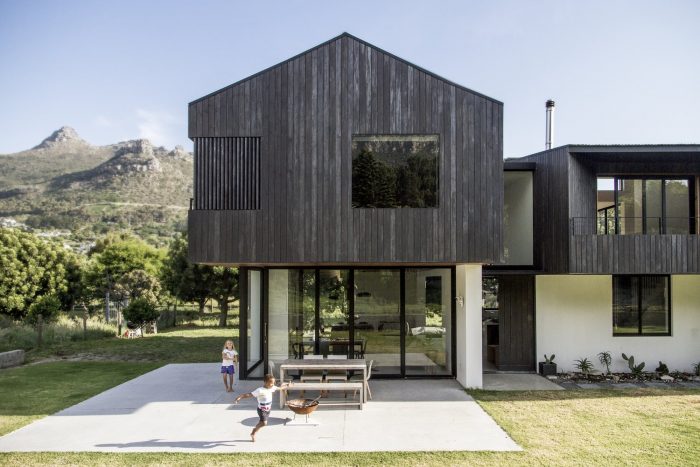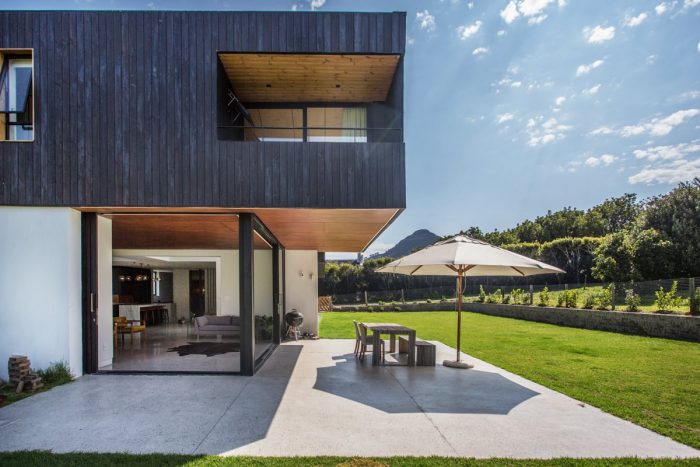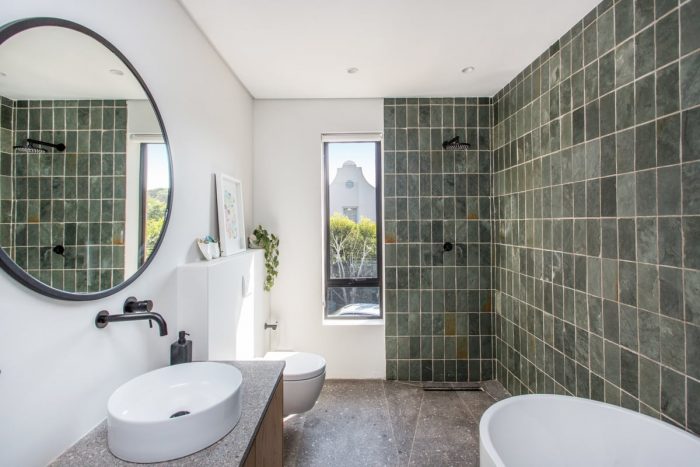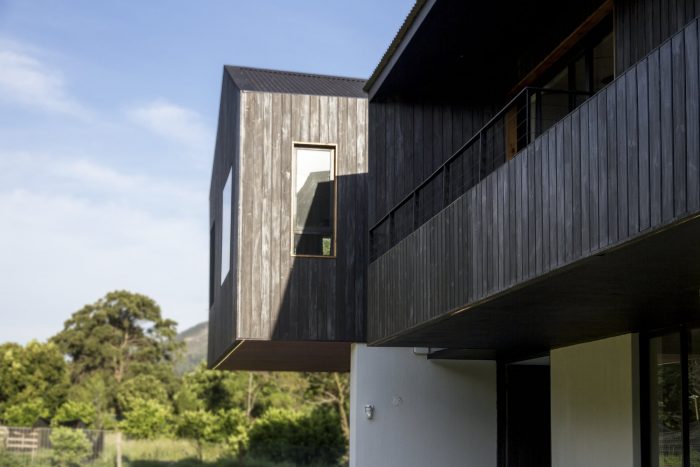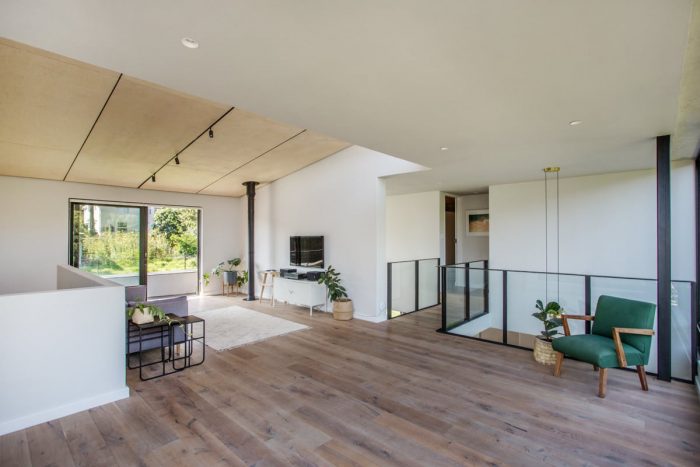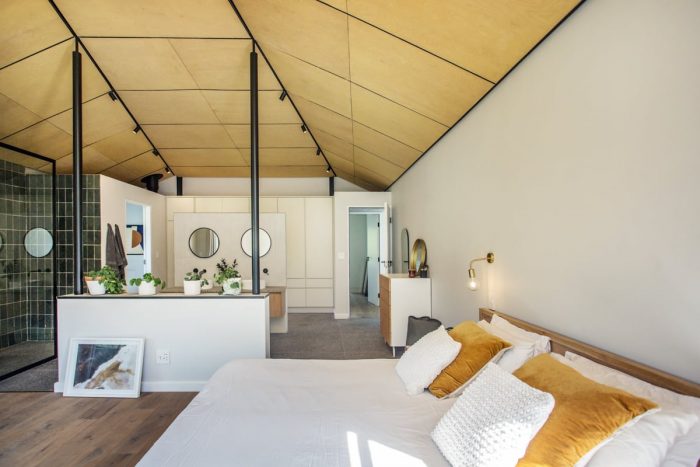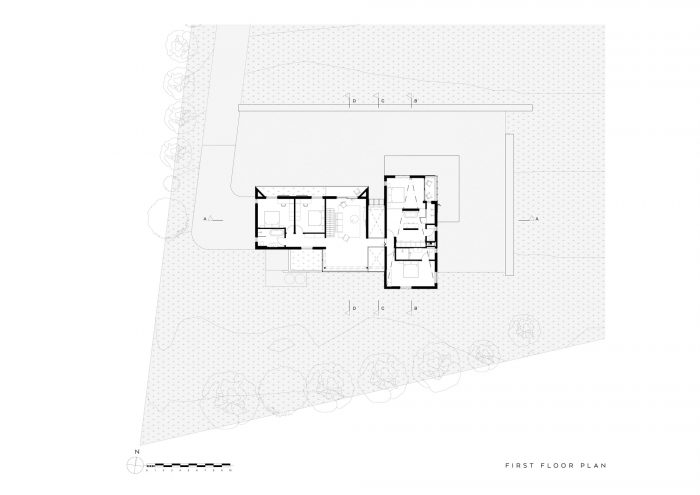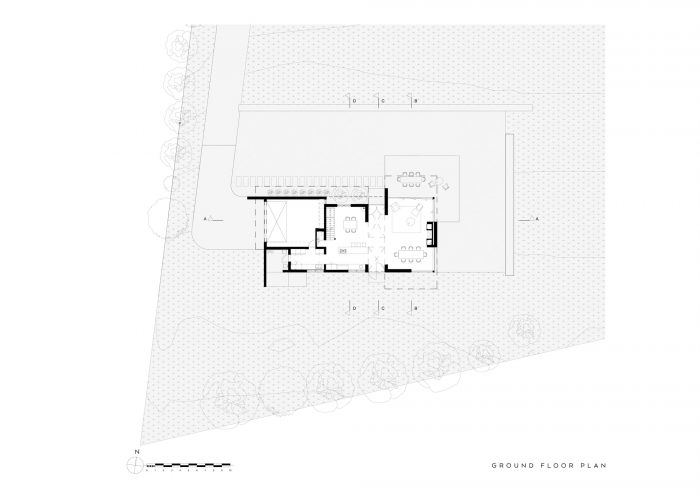这块处女地坐落在迪萨河旁边的山谷里,被南非开普敦桌山国家公园的各个山峰所包围。这个较大的地区被称为豪特湾,南非荷兰语中的 “豪特 “意为树林,指的是最初的荷兰殖民者在初到开普时在该地区发现了大量的黄木树。在大开普敦地区的发展过程中,该地区大多保持着农村的特点,其中一些较大的地块面积超过一公顷。
Nestled in a valley next to the Disa River, this virgin plot of land is surrounded by various peaks of Table Mountain National Park in Cape Town, South Africa. The larger area is known as Hout Bay, with the Afrikaans word “hout” meaning wood, referencing the large number of Yellow Wood trees the original Dutch Settlers found in the area when first arriving in the Cape. The area has mostly kept its rural character throughout the development of the greater Cape Town area with some of the larger plots exceeding a hectare in size.
在与客户的第一次讨论中,我们认为新的住宅需要借鉴该地区类似于农村的农场建筑类型,同时还要满足当代的需求。此外,该房产上已经有两座住宅,建筑的位置需要保持该地区的宽敞感。因此,建筑占地面积决定在不影响迪萨河生态的情况下,尽可能靠近河流的形状。通过将建筑置于更靠近东南角的位置,该地产上的其他住宅中只有一户来自新家。另外,通过把它放在这么远的地方,桌山的Geelklip Buttress和Myburgh Kloof的景色就不会被打断。
Upon first discussion with the client we agreed that the new dwelling needs to draw from the rural like typology of farm buildings in the area, whilst still accommodating contemporary needs. Furthermore, two dwellings already existed on the property, and the placement of the building needed to be done in such a way that the feeling of spaciousness of the area is maintained. The building footprint was consequently decided to take shape as close as possible to the river without compromising the ecology of the Disa River. By placing the building closer to the south-eastern corner, only one of the other homes on the property is from the new home. Also, by placing it so far back, uninterrupted views of Table Mountain’s Geelklip Buttress and Myburgh Kloof are afforded.
在确定了建筑在场地上的位置后,可以合理地推断出功能的位置。汽车库、洗碗间和服务院被安置在场地的西部边界:最接近邻近的房产。这使得该计划能够向该地产的北部和东部开放。东北角可以说是布局中最重要的部分。在这里,生活区通过空洞的玻璃推拉门向外部生活区开放,上面有悬臂式的主卧室。这个角落的重要性通过参考主卧室立面的传统谷仓式屋檐而得到强调。屋顶构成了设计的一个组成部分,是专门为解决建筑在景观中的规模而构思的。
Upon establishing the position of the building on the site, placement of the functions could be logically deducted. The car garage, scullery and service yard is placed towards the western boundary of the site: closest to the neighboring property. This allowed the plan to open up towards the north and east of the property. The north-eastern corner is arguably the most important part of the layout. Here the living area opens up via cavity sliding glass doors to an external living area covered by the cantilevering main bedroom above. The importance of this corner is emphasized with the reference to the traditional barn like gable on the main bedroom façade. The roof forms an integral part to the design and was conceived specifically to address the scale of the building in the landscape.
传统的屋檐末端向一条直线逐渐变细,从而参考了传统建筑,但又不失规模感。建筑的主入口是北边的山和南边的河之间的联系。入口处有大型的木质双门,打开后是一个双体量的空间,两端有玻璃框架,平坦的混凝土屋顶将两边的斜屋顶结构分开。入口空间在南端打开,有一个中央转轴门,向通往迪萨河的花园打开。这个入口空间也是一楼厨房和生活区之间的门槛,也是主卧室和孩子们的卧室之间的分隔。
The traditional gable ends taper towards a straight line, thereby referencing traditional architecture without an imposing scale. The main entrance to the building acts as link between the mountains to the north, and the river to the south. The entrance opens with large timber double doors, opening up to a double volume space framed with glass on either end and a flat concrete roof separating the two angled roof structures on either side. The entrance space opens at the southern end with a central pivot door that opens towards the garden leading to the Disa River. This entrance space also acts as a threshold between the kitchen and living areas on ground floor, and as separation between the main bedroom and kid’s bedrooms.
一些设计元素参考了农业家园的简单性–基本的几何形状和简单的材料色调。公共生活区与较为私密的卧室是有区别的。这是通过两种方式实现的:水平上的区别,以及材料上的对比。白色纹理的石膏墙框住了底层,朋友和家人可以在这里受到招待。上层–用黑色木材填充–是为卧室和家庭休息室保留的,可以俯瞰周围雄伟的山脉。
A number of design elements refer to the simplicity of an agricultural homestead – basic geometry with a simple palette of materials. The public living areas are distinguished from the more private bedrooms. This is done in a two-fold manner: a differentiation in level, and a contrast in material. White textured plastered walls frame the ground floor level where friends and family can be entertained. The upper floor – cladded in black timber – is reserved for the bedrooms and a family lounge overlooking the majestic mountains that surround the site.
Architects: SALT Architects
Area : 353 m²
Year : 2019
Photographs :Linda Smal
Manufacturers : Lunawood, Artmar, Colorplus, Eagle Lighting, Everite, Joos Joiners, Oggie Hardwood Flooring, Safintra
Engineering : AVCON Structural Engineers
Main Contractor : Musa Renovations and Projects
Architect In Charge : Jan Dirk Van Der Walt
Design Team : SALT Architects
Clients : Sean & Sharyn Sassen
Joinery : Joos Joiners
City : Ciudad del Cabo
Country : South Africa



